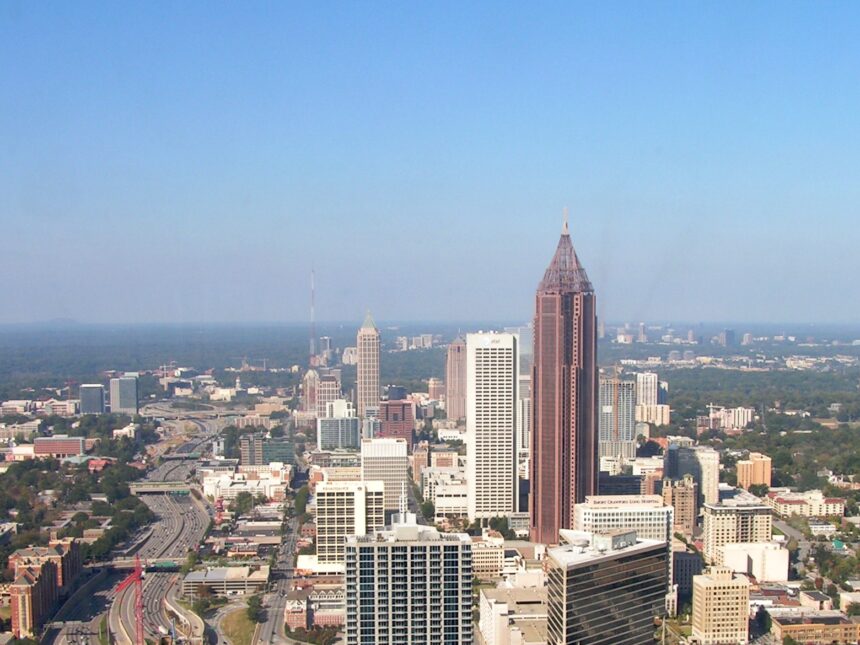A new report from The Annie E. Casey Foundation takes a solutions-oriented approach to the disparities that persist for Black Atlantans living on the Southside in accessing affordable housing, educational resources, and wealth-building opportunities.
Despite gains, racial inequalities have increased in Atlanta since 2019, according to the Casey Foundation’s new study, Changing the Odds: Comprehensive Solutions for Atlanta’s Future. The philanthropy produces the report every five years to report on the status of important issues facing Atlanta communities, such as expansion of high-quality housing, education and employment for Atlanta’s predominantly Black Southside neighborhoods.
For example, even though Black households are making more money since the Casey Foundation’s last report in 2019, the income gap with white households widened. By 2021, the average median income for a Black Atlanta household was $38,854 – a $6,000 increase in inflation-adjusted dollars from 2013 – but that compared with $114,195 for a white household. That’s a wealth gap of over $75,000 – a $3,500 increase since 2013.
We spoke with Kweku Forstall, who has led the Casey Foundation’s Atlanta Civic Site for over a decade, to find out more.
The Atlanta Civic Site works alongside partnered Casey foundation nonprofits to reduce racial inequalities for Atlanta’s predominantly Black Southside residents. Forstall and his team analyze the data that go into the Changing the Odds reports that they’ve been producing since 2015 – and coordinate community partnerships to work on solutions.
This interview has been edited for length and clarity.
Why does the Casey Foundation produce this report?
This report is the third in the series to understand how racial disparities were impacting Atlanta residents’ ability to access jobs, housing, education, and business opportunities. We published the first in 2015, then the second in 2019.
We track those trends over years – and we have some new ones emerging. We’re trying to see whether we’re closing any gaps.
How does that connect to the Atlanta Civic Site?
We focus on building long-term relationships and investing in long-term initiatives, people, organizations, leaders, and neighborhoods, here on Southside. We’ve been working in neighborhoods on the south side of the city, primarily those that are part of Neighborhood Planning Unit V (NPU-V). But we’re increasingly expanding to surrounding neighborhoods and really thinking about the city of Atlanta overall.
Did the findings of the most recent report match up with your expectations and projections? Was there anything that surprised you?
So in the report, you’ll see that we still have a tale of two cities. We have forgotten the blacks in recent decades in low-income neighborhoods. North of I-20 typically North Fulton, you know, that area north and north around 285, Georgia 400. There you have predominantly upper-middle-class white communities, as well as thriving businesses.
We don’t do any guessing on the ground since we’ve been working in the community for almost 25 years. We track what’s going on on a day-to-day basis and these reports allow us to examine data. Trends suggest progress in some cases and setbacks in others.
If you asked what our expectations were, we knew that the COVID-19 economic downturn, and even the racial reckoning that we experienced in 2020 and 2021 had an outsized impact on low-income communities of color, including black neighborhoods on the south side of Atlanta.
What we think about is how, despite all of the interruptions and disruptions, Atlanta continues to thrive. The economy’s growing, and everyone’s moving here, because of opportunity. It’s been called the best place in the country for black businesses to start and grow. But we’re finding that is not true for all the residents of Atlanta. And unfortunately, that fact breaks down by racial and geographic lines.
Economic opportunity in terms of jobs, business growth and development, new office park development and more is happening more frequently on the north side. So we weren’t really surprised at the impact of COVID-19. The economy slow down was outsized with regards to the black low-income communities on the south side. They didn’t have the benefit of years of investment. They don’t have the kinds of security in terms of economic stability.
What are some recommendations that come out of the report for addressing this gap in economic stability?
We want to talk about how we create living wage jobs on the south side. Another thing is the fact that people aren’t investing on the south side, and creating jobs through business development, construction, and other industries. We need more people to think about investing here and not continuing to build on top of what’s already been built on the north side.
Education is another barrier [to economic stability].
Moving on to early learning, we need to make sure that there is more availability of quality early learning home-based Early Learning Centers or services, as well as center-based services. This is an area where we’ve seen some improvement in the last few years. The amount of coverage of early learning is about 80% on this side of town which means roughly 80% of the need is being met. That is to say, there are roughly spots for about 80% of the population that need early learning support. We need it to be 100%.
Most of the people in this town are working and need early learning and childcare. They need to know that their children are in a quality environment so that they get off to a good start. We know a lot about the child’s brain development and how important it is to have early developmental opportunities. And there are examples of that happening. We need it to be for all children, not just for some children, even 80%.
We have the highest high school graduation rate in Atlanta public school history. It even exceeds the state’s high school graduation rate by 3 percentage points (87% vs. 84%).
But we also find that Atlanta public schools which are predominantly black have very few advanced placement, rigorous courses. The ones that are primarily on the north side of town, have many, many more advanced placement courses. And we all know that these kinds of offerings are a prerequisite for students who want to go on to post-secondary education or high-demand jobs.
So yes, high school graduation has improved. But how many of those students are going to have the courses needed to go on to whatever they choose? That is what we’re trying to peel back the onion on.
Another thing we can do is work together to make sure that renters know their rights. There has been some progress in this area as recent as the recent legislative session where renter’s rights have had incremental gains [HB 404]. People should not have to pay more than two months of security deposits to rent an apartment. They should not have to live in uninhabitable conditions. People can defend their rights and advocate for themselves. They have a right to protect themselves and their families.
All of it lends to stability and people staying in place. We don’t want people to leave the community because they can’t afford to stay, because they’ve been forced out.
How do people working on jobs, education and housing come together to affect communities?
We should be thinking of who we’re serving and who we want to stay in place. While new people are welcome to join the community, we want the people who are legacy residents who are in place already to benefit from the prosperity that is potentially at their fingertips.
How do we think about partnering so that housing is accessible, and people can stay in school and know that they are in a quality school that offers rigorous courses? How do we know that those neighborhoods have quality early learning opportunities so children can get off to a strong start? What kind of retail businesses are in those communities so that people can buy what they want in their community, including fresh food and fruit? We can talk about each component, but that isn’t comprehensive. That’s why the solutions need to be comprehensive.
What are some key takeaways that you’d like readers to have from the report?
One is that all of these things are interconnected. You can’t really isolate one thing. Housing affordability impacts your education which impacts job opportunities which impacts whether you live in a safe neighborhood where you can play outside and have recreational opportunities and that impacts your mental health.
So on the one hand, we don’t want to zero in on just one thing. What I will say is that the partnerships that are possible in this community can move the needle .
Beating the odds is a never-ending, exercise. Thinking of [these issues] on an individual basis suggests that it’s up to individuals to do it on their own.
Changing the odds requires us first to put on a community-wide hat and second to think in terms of systems – including local, and state policies – that prevent people from accessing opportunities and thriving. We want to change those odds, so people don’t have to continue to try to beat the odds.











